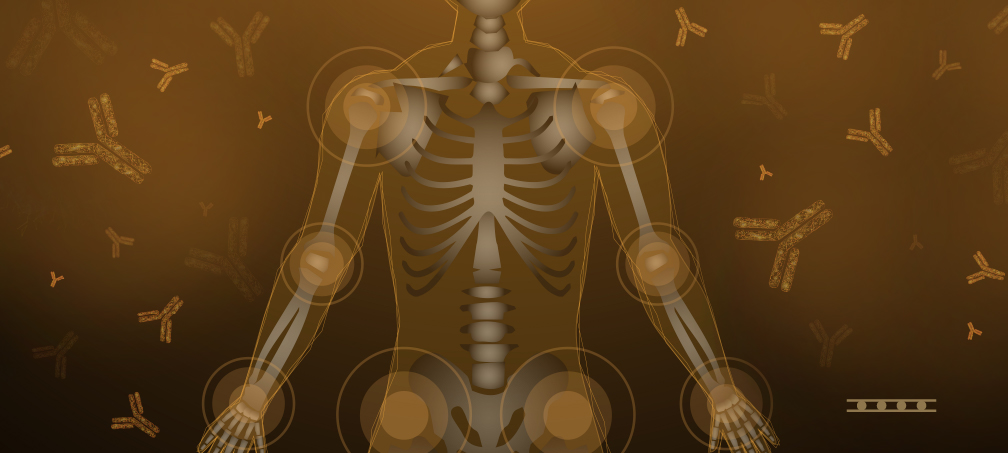Rheumatoid Arthritis (RA) is a chronic autoimmune disease that affects 0.5 to 1% of adults worldwide.1 RA is caused when the immune system sends antibodies to attack your joints, leading to joint destruction and disability. Symptoms of RA include joint pain, stiffness, swelling and decreased joint motility. While there is no current cure for RA, many patients have benefited from treatments aimed at reducing inflammation and pain, and through physical therapy to increase joint strength and mobility.2 Management of RA is best done within 3 to 6 months after symptoms start, since permanent joint damage can occur within the first 2 years.1 Since early management is needed to prevent irreversible joint damage, early diagnosis of RA is critical.
A majority of RA patients have antibodies in their blood which attack their joints.1 Such RA-specific antibodies occur before the onset of symptoms and can predict disease course. Therefore, RA-specific antibodies represent a useful tool in the early identification of RA. This blog will discuss the common antibodies which are tested for in RA diagnosis, and highlight additional uses of antibody testing in RA.
How is RA diagnosed?
To receive a positive diagnosis of RA, certain criteria must be met. In 2010, the American College of Rheumatology (ACR) and the European League Against Rheumatism (EULAR) developed such criteria for RA diagnosis.3 These criteria recommend, in addition to clinical symptoms, identification of both rheumatoid factors (RFs) and antibodies against citrullinated proteins, or anti-citrullinated protein antibodies (ACPAs).3 Clinical and laboratory findings are then assigned a certain number of points and, depending on the final score, the diagnosis RA is either excluded, uncertain or definitive
Role of antibodies in the diagnosis of RA
The most important autoantibodies in RA are RF and ACPA and those directed against Sa (citrullinated vimentin) and citrullinated enolase peptide 1 (CEP-1). These RA-associated antibodies are strong predictors of the disease and can be detected early, allowing for prompt diagnosis and management. RF was the first antibody to be discovered in RA patients and has a high sensitivity.4 However, RF specificity is limited because RF can also be found in healthy populations and other autoimmune diseases.4
For the detection of ACPA, mainly antibodies against cyclic citrullinated peptides (CCP) are detected. ACPA are highly predictive for RA development and the presence of such antibodies indicates more severe disease.1 ACPA levels can be detected in patient serum up to 14 years prior to the onset of symptoms.5 Anti-CCP antibodies exhibit a higher predictive value for RA compared to RF (79% vs 56%) but both antibodies are useful predictive indicators for the development of erosions and the degree of radiological progression in RA.6,7
Additional markers of RA are antibodies against citrullinated-enolase peptide-1 (anti-CEP-1). Anti-CEP-1 testing has been shown to be highly predictive for RA (97.6%) and may be useful as a supplementary test to anti-CCP testing for disease confirmation and for disease subtyping.8 Anti-CEP-1 antibodies occur in a subtype of RA that is associated with smoking and genetic factors. Therefore, anti-CEP-1 testing can be completed along with anti-CCP testing to identify patients in this category. Anti-CEP-1 is also an early marker of RA that can be detected ≥10.5 years prior to symptom onset.9
Using antibodies for RA treatment monitoring
Disease-modifying antirheumatic drugs (DMARDs) are commonly used in people with RA.10 Antibody levels have been shown to respond to DMARD treatment, and therefore represent a useful tool for therapy monitoring. For example, levels of ACPA have been shown to decrease in RA patients treated with DMARD.10 Additionally, changes in RF levels in response to treatment has been demonstrated and research has shown that RF positivity predicts better response to rituximab and tocilizumab treatment.4,11 Still more research is needed to demonstrate the usefulness of RF testing in treatment monitoring.
Key Takeaways
As of 2021, several autoantibodies have been identified in RA, many of which are directed against post-translationally modified proteins. In 2010, the international classification criteria for RA recognized the importance of RF and ACPA testing in the context of RA identification.3 The determination of RF and ACPA provides information about the disease course and gives other pathophysiological information. ACPA testing is highly sensitive for RA and has a high predictive value for disease onset and severity. The identification of antibodies other novel target antigens such as CEP-1 may be useful as a complement to RF an ACPA testing. Since a small percentage of RA patients may be seronegative for the typical RA-associated antibodies, it is important for scientists to continue to search for new biomarkers in RA.
References
- de Brito Rocha S, Baldo DC, Andrade LEC. Clinical and pathophysiologic relevance of autoantibodies in rheumatoid arthritis. Advances in Rheumatology. 2019;59(1):2.
- Kavuncu V, Evcik D. Physiotherapy in rheumatoid arthritis. MedGenMed. 2004;6(2):3-3.
- Aletaha D, Neogi T, Silman AJ, et al. 2010 Rheumatoid arthritis classification criteria: an American College of Rheumatology/European League Against Rheumatism collaborative initiative. Arthritis Rheum. 2010;62(9):2569-2581.
- Ingegnoli F, Castelli R, Gualtierotti R. Rheumatoid Factors: Clinical Applications. Disease Markers. 2013;35:726598.
- Nielen MMJ, van Schaardenburg D, Reesink HW, et al. Specific autoantibodies precede the symptoms of rheumatoid arthritis: A study of serial measurements in blood donors. Arthritis & Rheumatism. 2004;50(2):380-386.
- Silveira IG, Burlingame RW, von Mühlen CA, Bender AL, Staub HL. Anti-CCP antibodies have more diagnostic impact than rheumatoid factor (RF) in a population tested for RF. Clinical Rheumatology. 2007;26(11):1883-1889.
- Machold KP, Stamm TA, Nell VP, et al. Very recent onset rheumatoid arthritis: clinical and serological patient characteristics associated with radiographic progression over the first years of disease. Rheumatology (Oxford). 2007;46(2):342-349.
- Mahdi H, Fisher BA, Källberg H, et al. Specific interaction between genotype, smoking and autoimmunity to citrullinated alpha-enolase in the etiology of rheumatoid arthritis. Nat Genet. 2009;41(12):1319-1324.
- Carubbi F, Alunno A, Gerli R, Giacomelli R. Post-Translational Modifications of Proteins: Novel Insights in the Autoimmune Response in Rheumatoid Arthritis. Cells. 2019;8(7):657.
- Mikuls TR, O’Dell JR, Stoner JA, et al. Association of rheumatoid arthritis treatment response and disease duration with declines in serum levels of IgM rheumatoid factor and anti–cyclic citrullinated peptide antibody. Arthritis & Rheumatism. 2004;50(12):3776-3782.
- Maneiro RJ, Salgado E, Carmona L, Gomez-Reino JJ. Rheumatoid factor as predictor of response to abatacept, rituximab and tocilizumab in rheumatoid arthritis: Systematic review and meta-analysis. Semin Arthritis Rheum. 2013;43(1):9-17.





